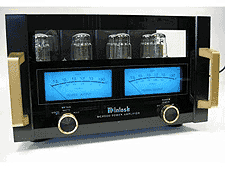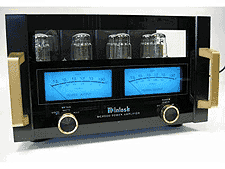


Giovanni Faccendini is the kind of guy who, if he hadn't chosen to sell high-end audio equipment, could have walked into Francis Ford Coppola's office and
Additional Resources
• Read more stereo amplifier reviews from HomeTheaterReview.com.
• Find an AV receiver to integrate with the amp.
• Discuss audiophile equipment on AudiophileReview.com.
Why McIntosh? It's arguable that Faccendini's company, MPI, is the most loyal of McIntosh's distributors, having handled the line for
Now it does.
As you'd expect, the '2000' denotes millennial import, but the real raison d'etre is McIntosh's 50th Anniversary (1949-1999). The company wanted to mark the occasion with something truly memorable, so, to this end, they 'coaxed out of retirement' one Sidney A. Corderman, the man responsible for some of the company's greatest triumphs - not least the MC275 power amplifier. Considering that the MIT-educated engineer was involved in the design of every McIntosh product from 1951 to 1993, it's only fitting that they turned to him to create this statement. What he's provided is the essence of McIntosh. The MC2000 could
Weighing a scary 135lb, or roughly a half-pound per watt, the MC2000 occupies a space measuring 11x17.75x18.75 (HWD) and - even if you switched off the massive blue-lit meters - dominates a room. It was amusing placing it next to the MC275; it made the latter look like a scale model. The chassis is made from stainless steel, finished in titanium gold, and the frame behind the fascia carries the engraved plaque reminding you that you own a limited edition. The black glass front panel is classic Mac with two gilt-edged knobs for power on/off and setting the watt-reading meters for peak or hold, with or without illumination; the meters are also used by engineers when biasing the tubes. Two huge handles flank the meters; above them is a window through which you can view the eight KT88 tubes for its 130W/ch output, four 12AX7A input tubes and two 12AT7 driver tubes. The valves occupy the front half of the unit; they fit into luxurious ceramic valve bases with gold-plated contacts and an air-pipe cooling system beneath.
McIntosh packs the valves in a separate box, with its foam insert cut to house each tube. The unit also comes with white gloves, a certificate of ownership, a comprehensive manual and a black mesh cage for the tubes' protection. But most users will probably prefer them al fresco.
Behind the glassware are four massive transformers, followed by a huge upside-down-U-shaped bar which acts as a carrying handle; it also protects the sockets. Positioned in mirror image from the outside-in are both single-end phono and XLR-balanced inputs, sturdy, gilded WBT multi-way binding posts for 2, 4 and 8 ohms, switches to change the sensitivity for balanced or single-ended operation, fuses, an IEC mains socket and one for connecting remote switch-on when used with McIntosh pre-amps.
Because I was able to hang on to this rare beast for over a month, I was able to try all manner of combinations, but did my serious listening with either the McIntosh C22 Reissue, GRAAF GM13.5B or the Musical Fidelity Nu-Vista pre-amps, while sources included the SME 10/SME V/Lyra Lydian analogue front-end and the Marantz CD-12. Speakers? This aroused the Wilson WATT/Puppy 6 like a kilo of rhino horn, and did things with the Sonus Faber Guarneri which border on the salacious. Which leads me to believe that an amp - as much as a source component or pre-amp - can be an
You have to appreciate that I have hundreds of hours with the associated components and feel that they hold no more surprises. Indeed, I'd used the very same components as a reference set-up with countless assorted power amps. I know the sound of the 'package' as well as can be expected. What wasn't anticipated was the way that the MC2000 made everything sound bigger, bolder, richer, more dynamic - I swear it even extracted additonal bass from the Guarneris.
Read more about the MC2000 on Page 2.
Note that there are not level-dependent phenomena; the improvements
were obvious regardless of volume - I keep handy a couple of trusty
analogue and digital Tandy SPL meters, mounted on a tripod at ear
height, just to make sure. The revelations were instantaneous, even
before the sucker grew warm enough to be stable. Moreover, it was
apparent long before the unit achieved what could be regarded as a
state of being fully 'run in'. And it just got better'n'better.
These are NOT products of 70mm/Cinerama/Mae
West/mescalin/steroid-induced larger-than-life-ism. Rather, it was a
throwback to the days when everyone used the same cliché to describe
increases in transparency: the lifting of veils. Only this time, it was
like someone had taken off the corsets and brassiere as well, and Big
Mama was ready to boogie. Even with near-kilowatt solid-state monsters,
I have
things coming close (or possibly bettering it) being the Audio Research
Ref. 600 or the Krell MRA. Admittedly, the WATT/Puppy combo hardly
taxes most power amps, but - and I hate to keep constantly reminding
you of this - I am not even remotely concerned with headbanging. My
listening hovers at 85-90dB at 2m, not a facsimile of a White Zombie
gig from the mosh pit.
It's a tube experience to silence any who still dare to defend
solid-state on any sonic grounds. You want controlled bass? Fast
transients? Rapid soft-to-loud-and-back rise and fall? And with warmth
and depth? And resolution? Aah, the latter is where the MC2000 goes
from the merely magnificent to the utterly mind-bending, and where it
defies those who say that valves lack the precision of trannies. With
the churning, roiling, grumbling remixes of 'Woke Up This Morning' on
Alabama's 3's
disproved every anti-valve claim I've ever heard. It managed to
separate the polyrhythmic jumble into identifiable strands while
retaining the whole; you could either zoom in on the bassist or
drummer, or sit back and absorb the entire wall of sound. At it wasn't
like using bifocals, where refocusing can drive you nuts: it was more
like aiming your mouse.
And the playing field is vast and open, with such precise locating
of the performers within that you can get out your tape measure.
Atmosphere? Try the remastered or MoFi
Then you'll know why I hate those artificial surround-sound settings
adored by the big Japanese brands. Man, I love that dual-mono...
By the time I got to Louis Prima, Dean Martin, Eva Cassidy, B.B.
King - what am I saying? This beauty cared not what the source was; it
merely amplified with utter command and cohesion all that it was fed.
Yes, balanced was preferred to single-ended. Yes, it needs running-in
and it's fussy about cables (mains, speaker and signal). Yes, it
responds differently to each of my assorted mains rings. Yes, it shows
up pre-amps with alacrity. But the best 'yes' of all? It reproduces
music with such veracity that it's made my (audio) life hell. I'm now
bereft. It's one of those pieces which I wish didn't have to go back...
In a key way, reviewing this amp is academic if not sadistic: as
with the Nu-Vista 300, the odds are that very few units will be left to
buy when this review appears. It has already attained 'collector'
status, and I suspect in the not-too-distant future that some poor slob
in Japan who missed out at the beginning will pay a premium for a mint
example. It is a truly great commemorative, a limited-edition delight
on a par with the various Leica specials and the 1989 Patek Philippe
anniversary watches. And I tell you this without a shred of doubt: if I
had the money, or I could only ever have one stereo power amp for the
rest of my life, the MC2000 would still be in my listening room.
Absolute Sounds, 58 Durham Road, London SW20 0DE. Tel 0181 971 3909, FAX 0181 879 7962
SIDEBAR:
Corderman designed the amplifier around McIntosh's patented Unity
Coupled Circuitry in which the output valves deliver power from both
the anodes and cathodes, instead of from the anodes alone. Its
'dual-mono-ness' is thorough, MC2000's two identical channels boasting
separate audio circuits, power supplies and power transformers -
everything that is bar the common AC lead. The four KT88s per channel
operate in parallel push-pull mode and with fixed bias; your dealer
needs to adjust them only when the tubes are replaced. In Unity Coupled
Circuitry, the tubes loaded in their cathodes, so they require a large
drive signal (approximately 170V) for full output, which is provided by
the 12AT7. The driver stage is fed by the 12AX7A input/phase inverter
with no coupling capacitors thus preventing the introduction of low
frequency phase shift.
To implement balanced or single-ended operation, the Big Mac's mode
selectors choose both balanced or unbalanced inputs and input
sensitivity either 1.2V or 2.5V; these operate 'Silent Electromagnetic
Switches' located at the inputs. During balanced operation, a second
12AX7A receives the balanced signal; one section of the driver tube is
a cathode follower passing the positive phase signal, the other
inverting the negative phase signal.
Additional Resources
• Read more stereo amplifier reviews from HomeTheaterReview.com.
• Find an AV receiver to integrate with the amp.
• Discuss audiophile equipment on AudiophileReview.com.